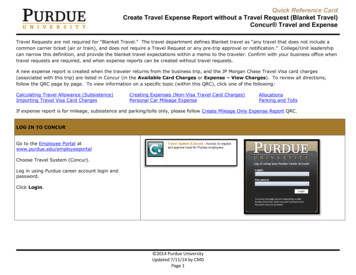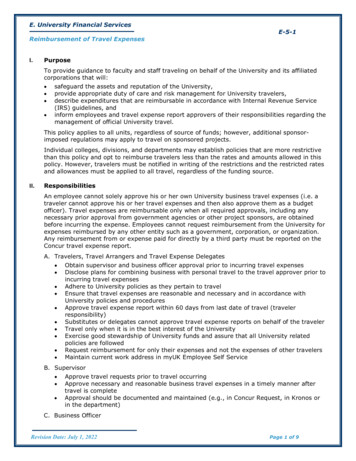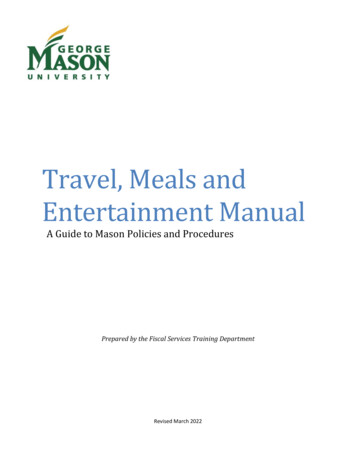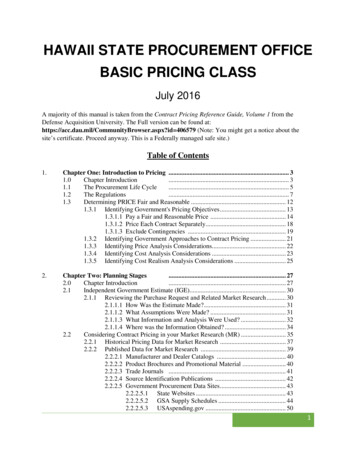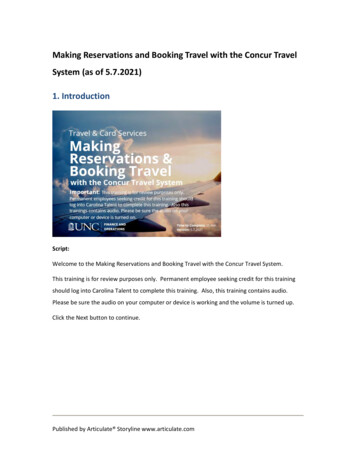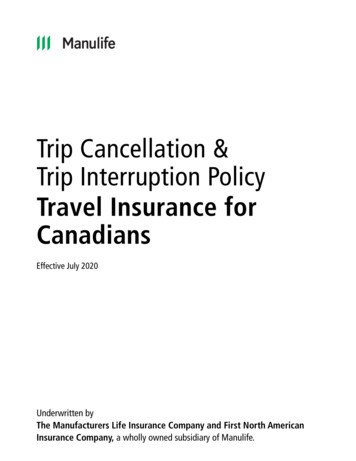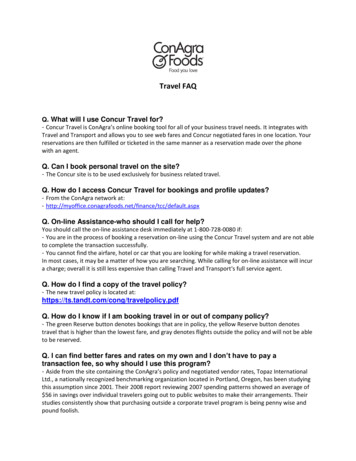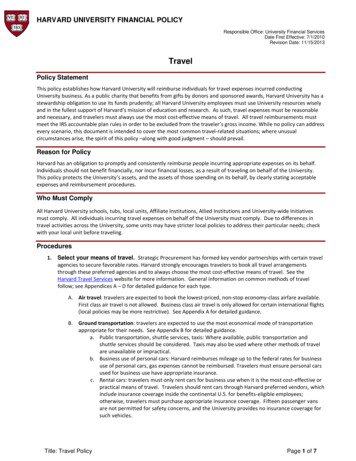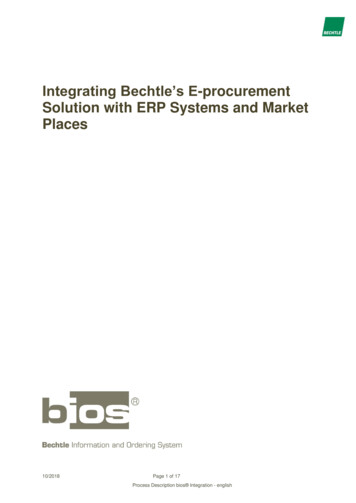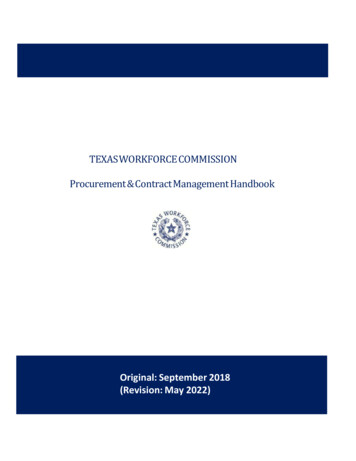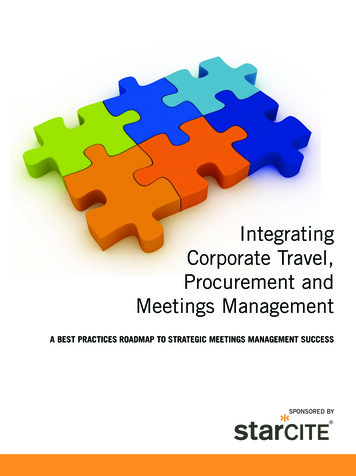
Transcription
IntegratingCorporate Travel,Procurement andMeetings ManagementA BEST PRACTICES ROADMAP TO STRATEGIC MEETINGS MANAGEMENT SUCCESSSPONSORED BY
Integrating Corporate Travel, Procurement and Meetings ManagementIntegrating Corporate Travel,Procurement andMeetings ManagementEven for companies with mature travel management programs, meetings oftenrepresent a fragmented and uncontrolled spend category. By integrating strategiesbetween travel and meetings departments, companies position themselves to reapbig rewards through increased spend visibility, control and compliance.EXECUTIVE SUMMARYAs the economy threatens corporate revenues, travel budgets are being scrutinized—and travel managers are being pressed—for further cost savings andtighter management controls. While many have proposed managing meetingsactivities more tightly in the past, such efforts have often been passed overby executives who either did not realize the magnitude of meetings spendwithin their organizations or simply could not see the path forward.White paper produced byMeetings spend is one of the least transparent spend categories in an organization. When corporations delve into the issue, they are likely to find that asmuch as 35 percent of travel spend is dedicated to meetings. With the progresstravel management has made over the past 10 years—incorporating procurement strategies, sophisticated booking and tracking tools, and strict suppliermanagement—the knowledge that organizations may leave more than a thirdof their leveraging power on the table should be an impetus for action. Butthe path toward integrating meetings and corporate travel is challenging.Companies must determine how to CONTENT SOLUTIONS Elizabeth West Directorelizabeth@promedia.travel Colette MirroCreative Directorcolette@promedia.travelLouis MagliaroEVP Sales & Marketinglouis@promedia.travelTim ReidPresident & CEOtim@promedia.travelSponsored by2 PROMEDIA.TRAVEL/WWW.PROMEDIA.TRAVEL Overcome decentralized data silosFind the synergies between travel and meetings that allow themto work toward common goalsCreate specific meetings policiesIntroduce strategic concepts to ad hoc processesAcquire the tools to guide processesAggregate data to increase leverage with suppliersIn this white paper, StarCite presents its latest industry research about wherecorporations stand when it comes to travel and meetings integration—and aroadmap for companies ready to reap the rewards of an integrated approach.TRAVEL AND MEETINGS MANAGEMENT: A COMPARISONIn August 2008, StarCite surveyed nearly 150 travel managers, purchasingexecutives, meetings managers and other titles related to travel and meetings togain insight into common practices each side has used to achieve its goals. Thestudy showed a wide gap between corporate travel and meetings strategies.In terms of policy, nearly 95 percent of respondents indicated they had eithera mandated or non-mandated travel management policy in place, and almost
55 percent of these respondents indicated thatpolicy compliance exceeded 75 percent. Thatcompared with only about 40 percent of companies that had established meetings policies, a circumstance that makes meetings policy compliancea less compelling inquiry (fig. 1).Interestingly, 39 percent of respondents saidthat their companies applied existing travel policyto meetings programs. While this approach canbe partially effective, a travel policy generally lacksspend categories that meeting planners use on a regular basis, such as ground transportation for groupsor support services like a destination managementcompany. Speaking on a recent webinar panel aboutthis topic, Linda McNairy vice president of businessdevelopment for StarCite, confirmed. “It’s notuncommon to begin with the travel policy,” she said.“Although I think most would agree that you quicklylearn that the travel policy does not apply to themeetings program and there is some tweaking thatneeds to be done.”Strategic sourcing is another area wheremeetings lagged behind (fig. 2). According tothe StarCite study, more than 71 percent ofcompanies had preferred supplier relationshipswith all three major travel categories: air, hoteland car rental. Only 5 percent lacked preferredrelationships as a whole. That situation was quitedifferent on the meetings side, where nearly32 percent of companies lacked preferredsuppliers entirely.Without preferred suppliers for meetings,corporations leave themselves open to multiplerisk factors. In the short term, it may be aproductivity issue. If performed thoroughly,researching suppliers and individually negotiating each supplier contract for each meetingPprogram is an extremely labor-intensive processthat a preferred supplier relationship should helpto streamline. In the long term, however, suchpractices easily become a financial or legalliability. As professional planners take on heavierworkloads, their ability to source and contractFIGURE 1POLICY IN FOCUSAlmost 95 percent of survey respondents revealed their companies had aworking travel management policy. Only 40.6 percent of respondents couldsay the same about meetings policies.TravelWhich best describes your company’s travel management policies?We do not havetravel policies3.0%2.2%Policies arenot established37.0%Policies areestablishedbut not supportedby mandates57.8%Policies areestablishedand supportedby corporatemandatesMeetingsDoes your company have a policy specific to meetings?20.3% 19.5%No, there isno policy in placeYes, and it isenforced21.1%39.0%No, but we useour T&E policyYes, but itis notenforcedPROMEDIA.TRAVEL/WWW.PROMEDIA.TRAVEL 3
Integrating Corporate Travel, Procurement and Meetings ManagementFIGURE 2SOURCING IN FOCUSThe vast majority of respondents surveyed had preferred supplier rela-Strategic sourcingis another areain which meetingsmanagementlags behindcorporate travelwhen it comesto implementingbest practices.tionships for travel programs. Not so for meetings.TravelWhich of the following best describes your travel management program?5.1%We do not have preferred suppliers11.0%We are tryingto establishpreferringsuppliers12.5%We havepreferredsuppliers71.3%We have preferred air,hotel and car rentalMeetingsWith what types of suppliers does your company have preferredrelationships for meetings?HotelAirCar RentalGroundTransportationNone of the above4 31.7%54.5%
thoroughly is diminished. Put ad hoc planners into the mix—who often lackcore competency in meetings and event planning—and the risk factors canrise significantly, whether in the form of steep attrition or cancellation fees,crisis planning or even basics, such as negotiating discounted group rates.A senior meetings professional for a Top 100 pharmaceutical and healthcompany, recounted her experience as the strategic meetings champion inher organization. “I have case study after case study of admins all goingto the same hotel. They’ve all gone to the same sales office and they’veall gotten different rates at the hotel for a small meeting,” she said. Tostreamline data collection for all meetings, a simple registration templatehas been devised that will be rolled out in 2009 to ad hoc planners. Thetemplate will feed meeting data into the company’s centralized meetingsmanagement tool and allow for better quality control.To that point, technology tools play a large role in any effective meetingsmanagement and integration initiative, but the survey suggests that it is anotherarea where many companies have not yet made the investment that will helpcontrol the planning process. Unlike the travel department, which is likely to relyprimarily on a TMC or online travel management software, meetings departmentsoften utilize multiple tools. The most prevalent for the companies respondingto the StarCite survey was the homegrown spreadsheet (see fig. 3).FIGURE 3MEETINGS MANAGEMENT TOOLSUnlike a traveldepartment, whichis likely to relyon a TMC oronline travelmanagementsoftware, meetingsdepartmentsutilize multipletools to manageactivity and spend.Spreadsheets are by far the most commonly used meetings management tool.What kinds of tools/technology systems does your company use to manage meetings?Transient travel management tools4.2%32.2%ERP financial softwareExpense reportingsoftware16.1%Meetings management EL/WWW.PROMEDIA.TRAVEL 5
Integrating Corporate Travel, Procurement and Meetings ManagementThe lack of consistency inherent in individualized spreadsheets could makeit impossible for a company to aggregate meaningful data to integrate withcorporate travel volume. This is a fundamental reason that more than 46percent of the companies surveyed do not integrate travel and meetingsdata—and nearly 27 percent more do so only on a limited basis.THE ROLE OF TRAVEL & PROCUREMENTMeetingsMetricsIdentifying a path for success is avital part of a meetings managementintegration effort. Be sure to putmetrics in place that can measureprogress from the beginning. TheNational Business Travel Associationoffers more guidance on meetingsMeetings departments support a layer of goals that travel departments do nottypically address. Whether it is training, client education and entertainment,rewarding a sales team or facilitating an executive roundtable, if a meetingdoes not achieve specific objectives, the resources have been wasted. In thepast, such goals might trump policy adherence or spending caps. Ascorporations tighten their financial belts, however, meetings managers mustfind ways to satisfy cost-cutting demands while still accomplishing eventobjectives. By taking cues from their travel management and procurementcounterparts—and working together toward common management goals—meetings managers can facilitate more streamlined processes, better riskmanagement and more control over meetings spend.metrics (www.nbta.org). But considerthe following:Service Attendee and sponsor satisfaction Cycle timesFinancial Spend Savings and cost avoidance Cost per person Cost per meeting resourceVolume How many meetings held,canceled, denied Average meeting durationResources Staffing hours Forecasted workflow6 PROMEDIA.TRAVEL/WWW.PROMEDIA.TRAVELTravel management is often versed in implementing and refining policies,homing in on key performance indicators, and sharing rolled up data in theform of executive reports. With so many companies lacking a specific meetings policy, travel and meetings departments should work together to studyrequirements for such a policy and use the travel policy to guide them.Meetings managers will need to bring specific requirements to the table andbe ready to justify when and how they are used. Simultaneous with policycreation, travel and meetings departments should create the metrics by whichtheir efforts will be measured (see “Meetings Metrics” sidebar, page 6) andconsider how this data will be collected and reported (see “Role ofTechnology” sidebar, page 8).Procurement traditionally brings a higher level of oversight to the meetingstravel equation. With a hard look at meetings process and standardization,meetings managers can work with procurement departments to streamlinesourcing and contracting—and, very importantly, can follow their leadto address some aspects of risk management.Procurement, and more recently travel, is versed in corporate RFP processesthat establish preferred suppliers in several key areas for meetings: air, hotel,and car rental. And for additional vendors, such as destination managementcompanies, third-party planning firms and production or audiovisual companies, procurement is likely to be able to assist in forging larger corporaterelationships that will result in cost savings and productivity increases.Further, procurement often brings contracting expertise to the table, whichmitigates liability.
Clearly, most companies have the expertise among travel, meetings andprocurement to reduce meetings costs and manage risks. But many areparalyzed by the seeming enormity of the task. They key is obtain executiveendorsement and then take the process step by step.UNCOVERING CURRENT MEETINGS SPENDOrganizational fragmentation is at the core of many challenges when it comesto meetings. Unlike a centralized travel department, which may ultimatelyreport to procurement or finance, accountability for meetings is often spreadthroughout the corporation (see fig. 4). According to the StarCite study, lessthan 50 percent of respondents indicated their companies had a centralizedmeetings team—and only 50 percent of those companies processed all of theirmeetings through that team. In many corporations, administrative assistants orother ad hoc planners have responsibility for small meetings that may fly underthe radar entirely. Finding these meetings centers and data repositories can bedifficult, but several avenues can be explored.Corporate card – Corporate cards are a good place to start a search sincethey’re a good source of meetings information, especially if the companyutilizes a dedicated meetings payment card. If not, work with the corporatecard provider to break out line items that are likely to be related to meetings:a meal with 10 or more diners, audiovisual charges, large hotel room blocksor banquet charges, etc.According to theStarCite study,less than 50percent ofrespondentsindicated theircompanies hada centralizedmeetings team.FIGURE 4RESPONSIBILITY FOR MEETINGS IS OFTENFRAGMENTED THROUGHOUT AN ORGANIZATION.In your organization, where does the ultimate responsibility for meetings report up /PurchasingMeetings andEventsShared Services/Business Support Services9.8%9.8% L/WWW.PROMEDIA.TRAVEL 7
Integrating Corporate Travel, Procurement and Meetings ManagementFinance and/or purchasing departments – Research expense reportsand purchase orders for similar line items listed above. Look for codesthat indicate meetings or event planning, hotel, conference center, etc.If the finance and purchasing departments do not break out these codes,work with them to implement strategic changes to further the meetingsmanagement initiative.BEST PRACTICEPaymentSolutionsConsider using a specialized meetingspayment card for all meeting purchas-Individual meeting planners – Some companies have as many differentmeetings spend tracking tools as there are meeting planners. Find out whoplans meetings for each business unit and ask them for their records—or ask managers to acquire them.Suppliers – Suppliers often track meetings spend better than their clients.Go to them with a spreadsheet listing the data required and ask for asmuch information as they can offer.es. This payment option offerscompanies an easy way to categorizeline items, reconcile accounts andstreamline the payment process.Many companies issue an individualmeetings card for every programCentral data/meetings management tool – If the company has a centraldatabase for meetings information or a meetings management tool, this wouldbe the best place to start. Keep in mind, the StarCite survey indicates only aminority of companies have such a resource. And without a strategic meetingsmanagement program and an adoption management strategy in place, there’sa significant likelihood that not all planners use the tool.registered and approved in acentralized data hub. All chargesCREATING POLICYto that account should be associatedIn order to create a meetings policy, a company must get a handle on thetypes of meetings its planners organize: sales, training, marketing events,industry conferences, executive retreats, incentive programs, etc. Each ofthese meeting types will have specific needs. A training program, for example, might incorporate several waves of attendees and use a conferencecenter that can provide extensive computer networking and IT services.A marketing meeting may require elaborate audiovisual for product introductions. An executive retreat or sales incentive may require an upgradedclass of service or destination management assistance to meet its objectives.All of these areas represent layers of objectives that traditional corporatetravel policies do not address.with the individual program and canbe fed to a meetings managementtool or other expense system for easyidentification. Meetings cards helpincrease visibility into individualprogram spend and alleviate many ofthe process dollars associated withcutting checks to individual vendors.It is a best practice to work with meetings stakeholders to define their needs anddetermine how they overlap with each other and with the travel department—asthis is where the process of integration can start. Certainly, travel and meetingspolicies surrounding air, hotel and ground transportation should be aligned tosupport each other as well as overall corporate goals. Further, the parties shouldwork together to create parameters around what planning tools should be usedand the processes that must be followed to create a consistent flow of data. Ifexceptions to policy may be made, a clear approval process should be in placeto control those exceptions and track them. Ramifications for non-complianceshould also be considered and clearly communicated.8 PROMEDIA.TRAVEL/WWW.PROMEDIA.TRAVEL
STRATEGIC SOURCING AND CONTRACTINGAs companies gain visibility into meetings spend and activities, they may beginto see patterns develop. Working together, travel, meetings and procurementmanagers should analyze these patterns, look at current contracts and discounts, if any, and determine how they measure up to benchmarks on the travelside. They should keep in mind, however, that meetings may not get the samepreferred rates as transient travel. For example, there are several mitigatingfactors when negotiating with a hotel for a meetings program. Time of year,availability, ratio of meeting space needed to sleeping rooms used, and likelyfood and beverage purchases often influence a planner’s ability to negotiatediscounted room rates and other items.Unlike transient travel contracts, which are traditionally negotiated annually,meeting planners are likely to negotiate each meeting separately taking manyvariables into consideration that are specific to that program. Nevertheless, asbetter volume data is introduced to suppliers, the easier it should be to increasesavings across the board. It is a best practice to work with a regional or nationalsales representative to relay an overall picture of meetings spend and to negotiate basic terms that may be refined for specific program purchases.Role ofTechnologyAlthough many companies have notacquired a central meetings management tool, the role of such technology cannot be overstated. Just asonline booking tools have revolutionized the travel managementspace, a technology solution alsobecomes the core of a meetingsmanagement program and facilitatesintegration. Not only do these toolshouse policy parameters and compliance checks, they also push outprocess prompts—whether relatedto approvals and sourcing or goingfurther into detailed planning logistics and attendee management.When considering a meetings management technology tool, look forthe following capabilities: In general, corporations have taken one of two approaches—either supportiveor dominant—when it comes to contracts, but the intention for both is to ensurethat a centralized authority has some degree of oversight for individual meetingcontracts. This ensures standard corporate clauses are included and minimizesliability. Whether procurement provides a supporting role or a dominant roledepends upon the corporation’s culture—and often upon the professional levelof the planners involved.For a supporting role, a new meetings policy might mandate that each contracta professional planner negotiates or modifies is subject to review by a centralindividual within procurement. Corporations should be careful, however, tounderstand the volume of their meetings contracts in order to provide the support and quick turn-around times a planner often needs. If purchasing is to playa more dominant role, it is wise to include meetings professionals within procurement to assist logistics-oriented planners in contract negotiations. Themeetings specialists, trained in procurement best practices, could also be thesignatory for the contracts.In an integration effort, all sourcing and contracting considerations should beviewed with the goal of aligning meetings and travel to achieve the most effective spend management overall. That may mean changes to both sides of thetravel-meetings equation. On the transient side, do current suppliers have theability to offer group travel services? A good example is ground transportation.If a company currently has a preferred black car or limo service, does thatsame supplier offer motor coach and van services? If not, it may be time fora change. Likewise, do preferred transient hotel properties offer adequate Approval traffickingMeetings budgeting toolsElectronic RFP facilitationProcess controlsAttendee management tools(online registration, pre- andpost-event survey tools)Integration with corporatepayment cards and automaticexpense data feed (see“Payment Solutions” sidebar,page 8)Data reporting and trackingThe most advanced tools in themarket have begun to integratewith GDS providers so that meetingattendees can link to a corporation’sonline booking tools directly fromattendee registration sites. This typeof partnership allows companies tocontrol compliance to travel policyeven as employees are directed tothe meeting room block. This hasbeen an ongoing challenge for manycorporations, and the newest developments are facilitating moreadvanced integration possibilities.PROMEDIA.TRAVEL/WWW.PROMEDIA.TRAVEL 9
Integrating Corporate Travel, Procurement and Meetings Managementmeeting space for the corporation’s needs? Or, on the meetings side, should ameeting destination be moved to make better use of current preferred travelsuppliers?In an integrationeffort, all sourcingand contractingshould be viewedwith the goal ofaligning meetingsand travel toachieve the mosteffective spendmanagementoverall.Organizations must look at how both travel and meetings needs can affect preferred supplier scenarios and decide how best to fit the pieces together to achievecost savings while preserving service levels. Technology tools can prompt and traffic approvals among different divisions, driving process automatically and collecting consistent meetings data along the way.DATA INTEGRATION AND RETURN ON INVESTMENTMeasuring return on investment for meetings-travel integration often happenson two levels. If an organization has not been managing meetings strategically,the first returns are likely to result from the initial meetings management push.StarCite’s McNairy presented the following statistics during a recent webinar tohelp guide savings icyComplianceStrategicSourcingVisibility10 PROMEDIA.TRAVEL/WWW.PROMEDIA.TRAVELSAVINGSHOW AND WHY3% to 6.5%Likely to result from productivityincreases, including reducedtime spent on managing logisticsand reduced outsourcing costs.1.6% to 5%Can result from avoidingpenalties and fines associatedwith SOX, reducing perks andgifts, and reducing risk viastandardized terms andconditions.4.8% to 8%Achievable through increasedleverage with suppliers,reduced agency commissions,and use of preferred suppliers.2.4% to 5.5%Possible through demandmanagement, budgetcompliance, and avoidingpenalties associated withattrition and cancellation.
The second layer of savings comes from leveraging new data with suppliers.Combined business intelligence from meetings and travel gives corporationsthe ability to increase their percent discounts with airlines and receive betterpreferred rates with hotels and car rental or ground transportation companies. Organizations should also look at how capturing additional travel spendinfluences soft dollar programs and rebates garnered from corporate cardusage. All of these areas represent savings opportunities, and as more companies integrate, actionable benchmarking data will become available.STRATEGIC MEETINGS MANAGEMENTIS A CONTINUOUS DISCIPLINEMaintaining an integrated travel and meetings management program is anongoing effort. Executive involvement is a must—not only at the beginningof the process but also to support changes that are made along the way. Travelmanagers know that as market conditions shift, travel policies, class-of-servicerequirements, supplier management techniques and market share must becontinuously refined. With an integrated program, the same goes for meetings,and the market drivers can be different for that segment. The key to creatingthe most effective program is to balance the needs of both sides of the travelmeetings equation, to leverage the expertise of procurement and to keep linesof communication open among stakeholders. Each side will need to compromise, work to minimize flaws and differences in the program parametersand concentrate on higher level enterprise goals to find creative pathwaysto success. Executiveinvolvement is amust not only atthe beginningof an integrationeffort but alsoto support changesmade alongthe way.BEST PRACTICEStandardized SourcingProcesses and ApprovalsWhen defining sourcing strategies, stakeholders must work togetherto standardize processes. Whether planners work directly through ameetings management tool, complete a meetings registration andapproval form or submit a request through a preferred third-partypartner, process is key to identifying the best supplier options andcollecting consistent data for each meeting. On the flip side,stakeholders must also work hard to ensure that the process movesquickly and does not encumber the planner. Sourcing processesthat move slowly put the corporation at a significant disadvantagewhen it comes to getting the right supplier and the best rates.PROMEDIA.TRAVEL/WWW.PROMEDIA.TRAVEL 11
Integrating Corporate Travel, Procurement and Meetings ManagementAbout StarCite, Inc,StarCite, Inc. is the largest on-demand global meetings management companyin the 300 billion global marketplace for corporate meetings and events.Processing more than 3 million attendee registrations a year and delivering over 7.5 billion in revenue opportunities annually to meetings suppliers, StarCitebrings together buyers and suppliers of meetings-related services on an unprecedented scale; delivering value through world-class technology and services toboth audiences. For more information, visit www.starcite.comAbout ProMedia.travel LLCProMedia.travel LLC is an integrated media company serving the informationneeds of the managed travel and meetings marketplace. ProMedia.travelpublishes Procurement.travel, Management.travel, TheTransnational.traveland TheBeat.travel. The company’s Content Solutions department effectivelydelivers sponsored content to targeted communities of travel professionals viae-newsletters, white papers, webinars, supplements and other vehicles. Formore information, visit www.promedia.travelSPONSORED BY
MEETINGS MANAGEMENT TOOLS Spreadsheets are by far the most commonly used meetings management tool. What kinds of tools/technology systems does your company use to manage meetings? 32.2% 4.2% 16.1% 26.3% 42.4% 18.6% Transient travel management tools ERP financial software Expense reporting software Meetings management tools Spreadsheets Other .
